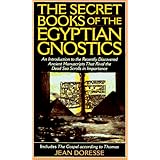
Average Reviews:

(More customer reviews)Jean Doresse's book was originally published in 1958 as the first authoritative description of the now famous cache of Egyptian Gnostic writings known as the Nag-Hammadi Library or, as Doresse calls it, the Chenoboskion Library. Despite the forty plus years since publication, a more readable and thorough introduction to the material is not to be found.
Until the Nag-Hammadi discovery, the Gnostics were thought to be no more than a heretical splinter group of early Christianity with particularly bizarre cosmologies and licentious sexual practices. Hardly surprising given that most of what we knew about the various sects of Gnostics came from their rivals, the Christians. Doresse thoroughly reviews what was known of Gnosticism before these writings of theirs were unearthed. As one of the original discoverers of these texts, his first person account of their unearthing, acquisition, and identification is quite engaging. A physical description of the books then is given. Finally he launches into a discussion of the texts themselves, and what they reveal to us of Gnostic belief and practice.
Doresse's excitement over these discoveries is palpable and renders the book lively and engaging to read where it easily could have been dry and academic. He outlines and discusses each of the texts with evident joy and wonder at now having so many ancient writings previously known only by title, if at all, and long thought to be lost. Part of his astonishment is due to the broad range of sources the Gnostics relied on. The library includes, Hermetic, Egyptian (of course), and Persian (Zoroastrian) material as well as a great deal of the expected, but previously lost apocryphal Christian material with Hebrew influence. This leads Doresse to wonder whether much of what we call Gnosticism is older than Christianity, perhaps being a component of the "soil" of ancient belief into which the seed of Christianity was planted. This would also explain some of the more obscure, Gnostic sounding passages of the New Testament that Doresse points out.
Some of the Nag-Hammadi writings were previously known to scholars, although no one expected that these texts would show up in a Gnostic collection. It was also a surprise to find adaptations of earlier known works selectively edited for Gnostic use, renamed, and attributed to authors with more authority. This practice does make it difficult to take at face value the Library's apparently Christian works attributed to the Apostles and even Jesus. At the same time, it also makes me wonder how much of the same thing went on when the "official" New Testament was put into its final form. Some things we may never know!
This is a book *about* the Nag-Hammadi Library, not - with one exception - a translation of the Library itself. It might be useful to keep a copy of the library at hand while reading the book. (The Library is available on line.) The single text from the Library included in this book is the sayings of Jesus titled the "Gospel of Thomas", which is accompanied by a table comparing each saying from "Thomas" with the sayings from the canonical Gospels (Matthew, Mark, Luke & John). I highly recommend this book to anyone interested in understanding the religious milieu of the early Christian era.
Click Here to see more reviews about: The Secret Books of the Egyptian Gnostics: An Introduction to the Gnostic Coptic Manuscripts Discovered at Chenoboskion

0 comments:
Post a Comment